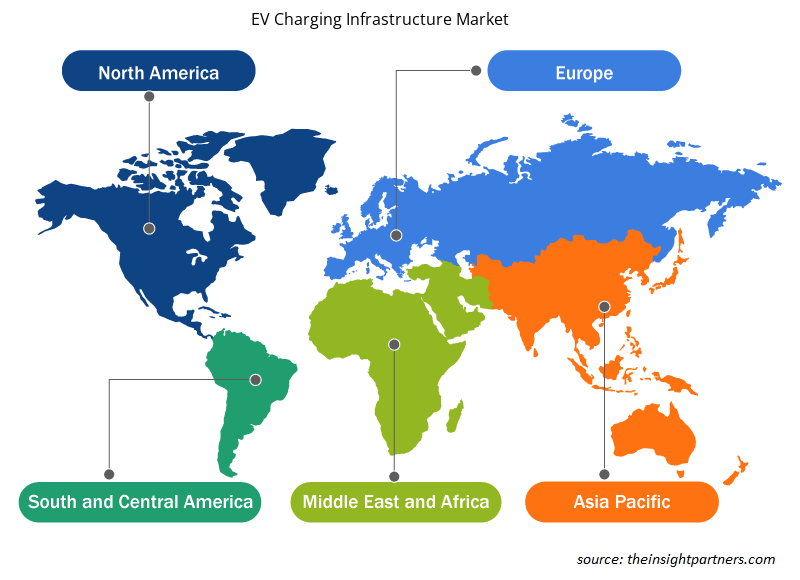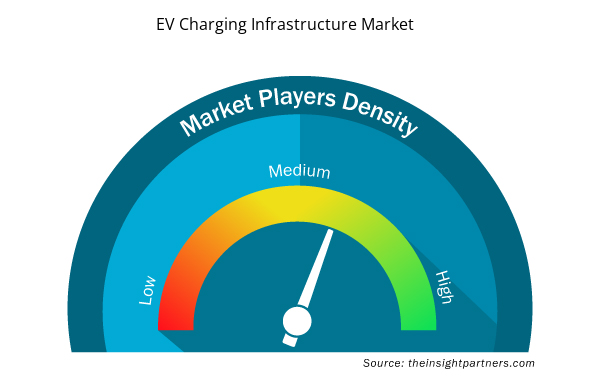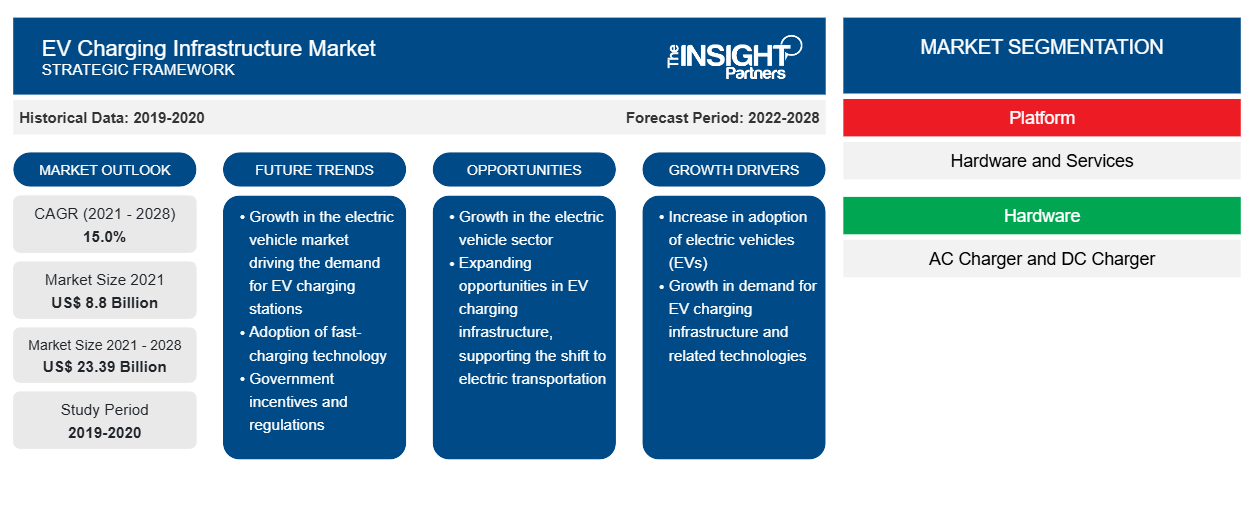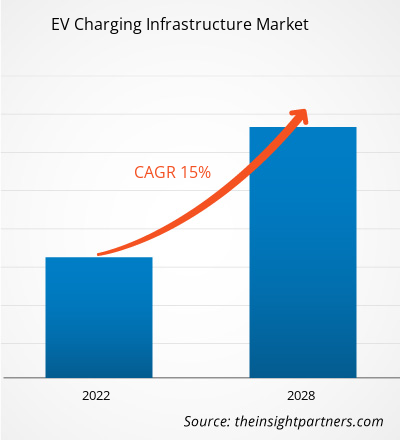[研究报告] 2021 年电动汽车充电基础设施市场价值为 88 亿美元,预计到 2028 年将达到 233.9 亿美元;预计 2021 年至 2028 年的复合年增长率为 15.0%。
分析师观点:
近年来,在全球向可持续交通转型的推动下,电动汽车 (EV) 充电基础设施市场取得了显着的增长和发展。随着越来越多的国家和政府优先采用电动汽车以降低温室气体排放和应对气候变化,对可靠高效充电基础设施的需求激增。电动汽车充电基础设施是指实现电动汽车充电的充电站网络和相关技术。这些充电站有多种形式,包括家庭、工作场所、公共和快速充电站。它们旨在满足不同的充电需求并为电动汽车车主提供便利。电动汽车充电基础设施市场的主要驱动力之一是不断扩大的电动汽车市场本身。随着电动汽车销量的持续增长,对强大充电基础设施的需求对于支持道路上越来越多的电动汽车变得至关重要。
此外,政府的举措、补贴和促进电动汽车普及的法规在推动充电基础设施的发展方面发挥了重要作用。多家公司和利益相关者积极参与电动汽车充电基础设施市场。其中包括知名汽车制造商、能源公司、充电网络运营商和技术提供商。他们合作开发创新的充电解决方案,提高充电速度,改善用户体验。快速充电基础设施对于长途旅行和减少里程焦虑至关重要,让电动汽车车主能够在长途旅行中快速为车辆充电。此外,将可再生能源整合到充电基础设施中也越来越受欢迎。可再生能源充电站有助于减少与充电相关的碳排放,使整个电动汽车生态系统更加可持续和环保。
市场概况:
电动汽车充电站是一种硬件,用于将插电式电动汽车和电动汽车连接到电源进行充电。私营企业或电力公司将充电站放置在停车场、购物中心等公共区域。三脚插头、公共充电站和家用壁挂式充电器都是从电网为电动汽车充电的简单方法。预计车辆到电网 (V2G) 技术将使车主能够在未来几年在高峰时段将多余的电力转售给电网。
定制此报告以满足您的需求
您可以免费定制任何报告,包括本报告的部分内容、国家级分析、Excel 数据包,以及为初创企业和大学提供优惠和折扣
- 获取此报告的关键市场趋势。这个免费样品将包括数据分析,从市场趋势到估计和预测。
市场驱动因素:
电动汽车市场扩张带动电动汽车充电基础设施市场增长
电动汽车 (EV) 市场的发展是电动汽车充电基础设施市场增长的重要驱动力。随着对电动汽车的需求不断增长,强大而广泛的充电基础设施变得至关重要。多种因素推动了电动汽车市场的不断扩大。人们对环境问题的认识和关注度不断提高,包括气候变化和空气污染。电动汽车技术的进步,包括提高电池容量和延长行驶里程,增强了电动汽车的吸引力和实用性。随着电池技术的不断发展,电动汽车在性能和续航里程方面变得更具竞争力,解决了潜在买家对行驶距离有限和充电可用性的担忧。此外,汽车制造商正在大力投资电动汽车车型的开发。汽车行业的主要参与者正在各个汽车领域推出越来越多的电动汽车选项,以满足不同消费者的偏好和需求。随着电动汽车市场的扩大,对全面充电基础设施的需求变得至关重要。电动汽车车主需要方便可靠的充电解决方案,以便轻松高效地为他们的汽车充电。这种需求不仅限于住宅充电选择,因为电动汽车车主需要在工作场所、公共场所和高速公路上使用充电站来支持他们的日常通勤和长途旅行。充电基础设施提供商、能源公司和其他利益相关者认识到投资和扩大充电网络以满足更大电动汽车车队需求的重要性。他们正在与政府、汽车制造商和其他行业参与者合作,开发可扩展、可靠且广泛可用的充电解决方案。
节段分析:
根据平台,电动汽车充电基础设施市场细分为硬件和服务。硬件部分在 2020 年占据了最大的市场份额。由于多种因素,硬件部分是电动汽车充电基础设施市场的最大股东。充电站遍布各地,这为其占据主导地位做出了贡献。该部分包括充电站的制造、安装和维护,充电站是充电基础设施的支柱。包括 1 级、2 级和直流快速充电器在内的多样化充电解决方案推动了硬件部分的市场份额。充电硬件的技术进步和物理基础设施投资寿命的延长进一步巩固了其地位。硬件部分更大的市场份额反映了其资本密集型性质以及在建立可靠、高效的充电网络中的关键作用。
区域分析:
2021 年亚太地区电动汽车充电基础设施市场价值为 39.9 亿美元,预计到 2028 年将达到 107.7 亿美元;预计在预测期内,复合年增长率为 15.2%。亚太地区通过几个关键因素在电动汽车充电基础设施市场中占据主导地位,这些因素促进了该地区的增长和市场份额。该地区的电动汽车普及率大幅上升,成为全球最大、增长最快的电动汽车市场。中国、日本和韩国等国家通过强有力的政府支持、激励措施和雄心勃勃的减排目标推动了电动汽车的普及。这个不断增长的电动汽车市场对电动汽车充电基础设施产生了巨大的需求,从而使该地区占据了主导地位。亚太地区受益于发达的制造业生态系统,尤其是在中国和韩国等国家。这些国家在制造充电站、电缆和相关组件方面进行了大量投资,从而以具有竞争力的价格提供了充足的充电基础设施供应。这促进了充电解决方案的部署,并提高了消费者的可及性。此外,该地区坚定地致力于建设一个全面的充电网络。各国政府和行业利益相关者一直在积极扩大充电基础设施,包括住宅区、商业综合体、公共场所和主要交通走廊。这个广泛的网络确保了电动汽车车主的便利性和可达性,进一步巩固了该地区的主导地位。技术进步和创新也为亚太地区的市场主导地位做出了贡献。采用大功率充电站和智能充电解决方案以及探索无线充电等新兴技术提高了电动汽车充电的效率和用户体验。这些进步吸引了更多消费者购买电动汽车,并刺激了对充电基础设施的需求。
此外,该地区的领先公司和市场参与者也发挥了重要作用。比亚迪、蔚来、现代和 LG 电子等亚洲制造商已在充电基础设施方面投入大量资金,并扩大了市场覆盖范围。他们的专业知识、技术进步和强大的市场影响力促进了亚太地区电动汽车充电基础设施市场的增长。
关键球员分析:
电动汽车充电基础设施市场分析包括 Tritium、Blink Charging Co.、ChargePoint, Inc.、BP plc、EVBox、EVgo Inc.、Tesla, Inc.、Webasto Group、RWE AG 和 Delta Electronics, Inc. 等参与者。在电动汽车充电基础设施参与者中,Tritium 和 EVBox 凭借提供多样化的产品组合位居前两名。
电动汽车充电基础设施市场区域洞察
Insight Partners 的分析师已详尽解释了预测期内影响电动汽车充电基础设施市场的区域趋势和因素。本节还讨论了北美、欧洲、亚太地区、中东和非洲以及南美和中美洲的电动汽车充电基础设施市场细分和地理位置。

- 获取电动汽车充电基础设施市场的区域特定数据
电动汽车充电基础设施市场报告范围
| 报告属性 | 细节 |
|---|---|
| 2021 年市场规模 | 88亿美元 |
| 2028 年市场规模 | 233.9亿美元 |
| 全球复合年增长率(2021 - 2028) | 15.0% |
| 史料 | 2019-2020 |
| 预测期 | 2022-2028 |
| 涵盖的领域 | 按平台
|
| 覆盖地区和国家 | 北美
|
| 市场领导者和主要公司简介 |
|
电动汽车充电基础设施市场参与者密度:了解其对业务动态的影响
电动汽车充电基础设施市场正在快速增长,这得益于终端用户需求的不断增长,这些需求源于消费者偏好的不断变化、技术进步以及对产品优势的认识不断提高等因素。随着需求的增加,企业正在扩大其产品范围,进行创新以满足消费者的需求,并利用新兴趋势,从而进一步推动市场增长。
市场参与者密度是指在特定市场或行业内运营的企业或公司的分布情况。它表明在给定市场空间中,相对于其规模或总市场价值,有多少竞争对手(市场参与者)存在。
在电动汽车充电基础设施市场运营的主要公司有:
- 德
免责声明:上面列出的公司没有按照任何特定顺序排列。

- 了解电动汽车充电基础设施市场的主要参与者概况
最新动态:
电动汽车充电基础设施市场中的公司普遍采用并购等无机和有机策略。以下列出了一些近期的关键市场发展:
- 2022 年 11 月,Yulu 与卡纳塔克邦政府签署了一份 MoU(谅解备忘录),并宣布计划在未来五年内投资 120 亿印度卢比部署 10 万辆电动汽车(EV)车队,并投入使用该邦最大的电动汽车电池充电和换电基础设施。
- 2022 年 10 月,卢森堡政府宣布,在首次征集为投资电动汽车充电基础设施项目的公司提供财政援助的项目后,已选出 29 个项目。参与其中的公司将获得高达 50% 的补贴,用于部署充电容量至少为 175 千瓦的充电站的投资。
- 历史分析(2 年)、基准年、预测(7 年)及复合年增长率
- PEST 和 SWOT 分析
- 市场规模价值/数量 - 全球、区域、国家
- 行业和竞争格局
- Excel 数据集


- Lyophilization Services for Biopharmaceuticals Market
- Quantitative Structure-Activity Relationship (QSAR) Market
- Aircraft MRO Market
- Intradermal Injection Market
- Bioremediation Technology and Services Market
- Micro-Surgical Robot Market
- Hot Melt Adhesives Market
- Collagen Peptides Market
- Electronic Data Interchange Market
- E-Bike Market

Report Coverage
Revenue forecast, Company Analysis, Industry landscape, Growth factors, and Trends

Segment Covered
This text is related
to segments covered.

Regional Scope
North America, Europe, Asia Pacific, Middle East & Africa, South & Central America

Country Scope
This text is related
to country scope.
常见问题
Asia Pacific dominated the EV charging infrastructure market in 2020 with a share of 45.2% and is expected to continue its dominance by 2028. Europe is the second-largest contributor to the global EV charging infrastructure market in 2020, followed by North America.
The major companies in EV charging infrastructure market are Tritium; Blink Charging Co; ChargePoint, Inc.; BP p.l.c.; EVBox; EVgo Inc.; Tesla, Inc.; Webasto Group; RWE AG; and Delta Electronics, Inc.
The IEC Mode in EV charging infrastructure includes 2, 3, and 4. In terms of market share, the market was dominated by the 3 segment in 2020.
Based on platform, the global EV charging infrastructure market is segmented into hardware, and services. The EV charging infrastructure market was dominated by the hardware segment in 2020.
The rising concern of the transportation sector's impact on the environment has led to an unprecedented global requirement of decarbonizing transportation to meet climate goals and limit global warming, thereby increasing the adoption of low carbon technology in the transportation sector. The rising concerns for the adverse impact of transportation-related emissions and shift of consumer behavior toward zero-emission vehicles have resulted in a significant increase in the adoption of light-duty passenger vehicles across the globe, especially in strong economies, such as the US, China, and the European Union. The global share of new passenger EVs has risen at an average of nearly 50% per year since 2015. In 2021, the sales of electric vehicles surged by 160% in these top three markets. Notably, China has the largest fleet of electric vehicles globally, with 4.5 million electric cars, and Europe witnessed the largest annual increase to reach a total of 3.2 million electric passenger vehicles.
Presently, EV charging stations are more common in private residences. However, the rising consumer demand has led to an active adoption of on-site commercial charging as a standard building feature. China, the EU-27 plus the UK, and the US, are expected to implement charging in residential and commercial buildings to scale up the EV charging infrastructure in the near future, which requires upgrading buildings' electrical infrastructure to satisfy the rising demand for EV charging. Additionally, EV charging at scale is subject to the careful planning of a building's electrical distribution system, along with the local electric-grid infrastructure. To enhance the accessibility and affordability of electric chargers, a large number of building developers, urban planners, and electrical-equipment suppliers are actively integrating the EV charging infrastructure into standard building design plans.
Trends and growth analysis reports related to Automotive and Transportation : READ MORE..
The List of Companies - EV Charging Infrastructure Market
- De’Longhi Appliances S.r.l.
- The Whirlpool Corporation
- Koninklijke Philips N.V.
- Breville
- SMEG S.p.A.
- Hobart
- Ankarsrum Kitchen AB
- Wonderchef Home Appliances Pvt. Ltd.
- Kenwood Limited
- Hamilton Beach Brands, Inc.
The Insight Partners performs research in 4 major stages: Data Collection & Secondary Research, Primary Research, Data Analysis and Data Triangulation & Final Review.
- Data Collection and Secondary Research:
As a market research and consulting firm operating from a decade, we have published and advised several client across the globe. First step for any study will start with an assessment of currently available data and insights from existing reports. Further, historical and current market information is collected from Investor Presentations, Annual Reports, SEC Filings, etc., and other information related to company’s performance and market positioning are gathered from Paid Databases (Factiva, Hoovers, and Reuters) and various other publications available in public domain.
Several associations trade associates, technical forums, institutes, societies and organization are accessed to gain technical as well as market related insights through their publications such as research papers, blogs and press releases related to the studies are referred to get cues about the market. Further, white papers, journals, magazines, and other news articles published in last 3 years are scrutinized and analyzed to understand the current market trends.
- Primary Research:
The primarily interview analysis comprise of data obtained from industry participants interview and answers to survey questions gathered by in-house primary team.
For primary research, interviews are conducted with industry experts/CEOs/Marketing Managers/VPs/Subject Matter Experts from both demand and supply side to get a 360-degree view of the market. The primary team conducts several interviews based on the complexity of the markets to understand the various market trends and dynamics which makes research more credible and precise.
A typical research interview fulfils the following functions:
- Provides first-hand information on the market size, market trends, growth trends, competitive landscape, and outlook
- Validates and strengthens in-house secondary research findings
- Develops the analysis team’s expertise and market understanding
Primary research involves email interactions and telephone interviews for each market, category, segment, and sub-segment across geographies. The participants who typically take part in such a process include, but are not limited to:
- Industry participants: VPs, business development managers, market intelligence managers and national sales managers
- Outside experts: Valuation experts, research analysts and key opinion leaders specializing in the electronics and semiconductor industry.
Below is the breakup of our primary respondents by company, designation, and region:

Once we receive the confirmation from primary research sources or primary respondents, we finalize the base year market estimation and forecast the data as per the macroeconomic and microeconomic factors assessed during data collection.
- Data Analysis:
Once data is validated through both secondary as well as primary respondents, we finalize the market estimations by hypothesis formulation and factor analysis at regional and country level.
- Macro-Economic Factor Analysis:
We analyse macroeconomic indicators such the gross domestic product (GDP), increase in the demand for goods and services across industries, technological advancement, regional economic growth, governmental policies, the influence of COVID-19, PEST analysis, and other aspects. This analysis aids in setting benchmarks for various nations/regions and approximating market splits. Additionally, the general trend of the aforementioned components aid in determining the market's development possibilities.
- Country Level Data:
Various factors that are especially aligned to the country are taken into account to determine the market size for a certain area and country, including the presence of vendors, such as headquarters and offices, the country's GDP, demand patterns, and industry growth. To comprehend the market dynamics for the nation, a number of growth variables, inhibitors, application areas, and current market trends are researched. The aforementioned elements aid in determining the country's overall market's growth potential.
- Company Profile:
The “Table of Contents” is formulated by listing and analyzing more than 25 - 30 companies operating in the market ecosystem across geographies. However, we profile only 10 companies as a standard practice in our syndicate reports. These 10 companies comprise leading, emerging, and regional players. Nonetheless, our analysis is not restricted to the 10 listed companies, we also analyze other companies present in the market to develop a holistic view and understand the prevailing trends. The “Company Profiles” section in the report covers key facts, business description, products & services, financial information, SWOT analysis, and key developments. The financial information presented is extracted from the annual reports and official documents of the publicly listed companies. Upon collecting the information for the sections of respective companies, we verify them via various primary sources and then compile the data in respective company profiles. The company level information helps us in deriving the base number as well as in forecasting the market size.
- Developing Base Number:
Aggregation of sales statistics (2020-2022) and macro-economic factor, and other secondary and primary research insights are utilized to arrive at base number and related market shares for 2022. The data gaps are identified in this step and relevant market data is analyzed, collected from paid primary interviews or databases. On finalizing the base year market size, forecasts are developed on the basis of macro-economic, industry and market growth factors and company level analysis.
- Data Triangulation and Final Review:
The market findings and base year market size calculations are validated from supply as well as demand side. Demand side validations are based on macro-economic factor analysis and benchmarks for respective regions and countries. In case of supply side validations, revenues of major companies are estimated (in case not available) based on industry benchmark, approximate number of employees, product portfolio, and primary interviews revenues are gathered. Further revenue from target product/service segment is assessed to avoid overshooting of market statistics. In case of heavy deviations between supply and demand side values, all thes steps are repeated to achieve synchronization.
We follow an iterative model, wherein we share our research findings with Subject Matter Experts (SME’s) and Key Opinion Leaders (KOLs) until consensus view of the market is not formulated – this model negates any drastic deviation in the opinions of experts. Only validated and universally acceptable research findings are quoted in our reports.
We have important check points that we use to validate our research findings – which we call – data triangulation, where we validate the information, we generate from secondary sources with primary interviews and then we re-validate with our internal data bases and Subject matter experts. This comprehensive model enables us to deliver high quality, reliable data in shortest possible time.


 获取此报告的免费样本
获取此报告的免费样本